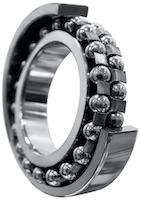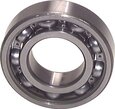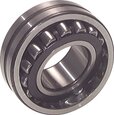Bearing part Numbers

Figure 1: Self-aligning ball bearing
Bearings support mechanical rotating bodies, thus reducing their coefficient of friction during movement and ensuring better accuracy of rotation. Bearings are used in a wide range of mechanical applications and adhere to standardized designs and international regulations. International bodies like ISO and ANSI regulate a portion of bearing’s regulations, leaving innovation space for manufacturers and a chance to develop unique designs that are specifically devised to help distinguish themselves from other producers.
However, there aren’t strict standards for bearing part numbers, resulting in unique part number schemes specific to each manufacturer. Therefore, to replace a bearing from one manufacturer to another is not always straightforward based on the part number. The process of decoding the part numbers in a roller bearing series is discussed below.View our online selection of bearings!
Meaning of numbers in bearing series
The designation of a roller bearing part number consists of a basic number, surrounded by auxiliary codes- suffixes and prefixes, which describe the internal clearance, tolerance, and other design parameters.
A bearing part number typically has 3 to 5 digits. These digits typically inform the following:
- Type of bearing
- Bearing size
- Width (B, C, T, or H)
- Outer diameter (D)
- Bore diameter (d or de)
- Chamfer dimensions (R)
- Series number
- Contact angle
As an example, the typical bearing part numbering will look like 'A BC DE.' Consider an example shown in Figure 2. The overall bearing designation looks like Prefix A BC DE suffix.

Figure 2: Bearing part number
The suffix and prefix are separated from the rest of the designation number by a hyphen, space, or an oblique stroke. Figure 2 shows the bearing part number as S 1 27 02 2, decoded as follows:
- S: Prefix, which precedes a typical bearing part number
- A: Bearing type symbol, equal to 1
- BC: Bearing size, with width series symbol 2 and outer diameter series symbol 7
- DE: Bore diameter code, equal to 02
- 2: Suffix, which succeeds a typical bearing part number.
The width and the outer diameter (BC) are internationally standardized, also referred to as the dimensional series of the bearing. The dimensional series (BC), together with the bearing type (A), is referred to as the bearing series symbol (ABC).
The individual parts of a bearing part number can be compared against the values given in the tables below to get adequate information about the bearing being used.
If the diameter of the bore is greater than 20mm, multiply the bore diameter (which is given as a two-digit code DE) with 5 to get the actual bore diameter in mm. For bore diameters less than this value, use the code identifications in Table 1.
Bearing code identification
Table 1: Bearing code identification if the bore diameter< 20 mm
| Bore Diameter | 10 mm | 12 mm | 15 mm | 17 mm |
| Code | 00 | 01 | 02 | 03 |
Codes for bearing types
The codes used for bearing types are represented in Table 2 and are satisfactorily agreed upon throughout the industry.
- The letters BC represent the size of the external diameter of the bearing and how wide it is.
- The series numbers go from 7-8-9-0-1-2-3-4 for the outer diameter, with 7 being the smallest diameter and 4 the largest.
- The codes go from 8-0-1-2-3-4-5-6 for the width of radial bearings, with 8 being the smallest width and 6 the largest.
- The codes go from 7-9-1-2 for the height of thrust bearings, with 7 being the smallest and 2 the biggest.
Prefixes are used to define the variations or components of a bearing. Suffixes indicate design parameters like bearing external or internal design (seals, snap ring groove), materials and heat treatment, cage design, and clearance. Tables 3-5 show common prefixes and suffixes used in roller bearing designations.
Table 2: Codes used for bearing types
| Bearing Type | SKF | NSK | Timken | FAG |
| Double row angular contact ball bearing | 0 | 3,5 | 3 | |
| Self-aligning ball bearing | 1 | 1 | 1,2 | 1 |
| Spherical roller bearing, spherical roller thrust bearing | 2 | 2 | 2 | 2 |
| Tapered roller bearing | 3 | 3 | 3 | 3 |
| Double row deep groove ball bearing | 4 | 4 | 4 | |
| Thrust ball bearing | 5 | 5 | 5 | 5 |
| Single row deep groove ball bearing | 6 | 6 | 6 | 6 |
| Single row angular contact ball bearing | 7 | 7 | 7 | 7 |
| Cylindrical roller thrust bearing | 8 | 8 | ||
| CARB toroidal roller bearing | C | |||
| Cylindrical roller bearing | N | NU, N, NU, NN | NU, NN, N, NF | N, HCN, NN, NNU |
| Four-point contact ball bearing | QJ | QJ | ||
| Tapered roller bearing in accordance with ISO 355 | 00 | 01 | 02 | 03 |
| Separable ball bearing | BO, E, L |
Common prefixes and suffixes used in roller bearing designations
Table 3: Prefixes- NSK Bearings
| Meaning | Bearing with special dimensions | Bearing with flanged outer ring | Higher load rating | Miniature metric bearing with special dimensions | Bearing outer ring with rollers and cage, no inner ring | Miniature bearing made from extra corrosion-resistant steel |
| Code | B | F | HR | MR | R | -H- |
Table 4: Suffixes- Clearance | ||||||
| Meaning | Normal radial internal clearance (RIC) | Radial internal clearance smaller than C2 | Radial internal clearance smaller than normal radial internal clearance greater than normal | Radial internal clearance greater than normal | Radial internal clearance greater than C3 | Radial internal clearance greater than C4 |
| Code | C0/CN | C1 | C2 | C3 | C4 | C5 |
Table 5: Suffixes used by established brands
| Meaning | SKF | NSK | Timken | FAG |
| Angular-contact ball bearing with 30-degree contact angle | A | A | T | |
| Angular-contact ball bearing with 25-degree contact angle | ACD | A5 | A | E |
| Angular-contact ball bearing with 40-degree contact angle | B | B | J | B |
| Double-row angular contact ball bearing with a contact angle of 25 degrees | B | B | B | |
| Universal angular contact ball bearing with a contact angle of 40 degrees | BG, B(E) C | BG, BWG | BUA | |
| Angular-contact ball bearing with 15-degree contact angle | CD | C | C | |
| Spherical roller bearing with high load capacity, machined cage | CA | |||
| Spherical roller bearing with high load capacity, pressed cage | CD | |||
| Deep groove ball bearing with d<10mm and contact seal on one side | RS1 | D | RSR | |
| Deep groove ball bearing with d<10mm and contact seal on both sides | 2RS1 | DD | 2RSR | |
| Deep groove ball bearing with contact seal on one side. | RS1 | DU | RSR | |
| Extra capacity design | E | E | E | |
| Tapered bore (taper 1:12) | K | K | K | |
| Solid brass cage, rip-guided | MA(MB) | M | MA(MB) | |
| Solid brass window-type cage | MP | MA1 | MP | |
| Solid brass cage, outer ring rip-guided | MA6 | MB | M1A | |
| Solid brass cage, guided by rolling elements | M | MR | M | |
| Bearing with snap ring groove in the outer ring of the bearing | N | N | N | |
| Polymer cage | T | T | T | |
| Pressed steel cage, one-piece | J | W | J | |
| Full complement roller bearing | V | V | V | |
| Non-contact seals on both sides | 2RZ | VV | PP | 2RSD |
| Deep groove ball bearing with single shield | Z | Z | D | Z |
| Deep groove ball bearing with double shield | ZZ | ZZ | DD | ZZ |
| External dimensions in line with ISO | X | X | X |









